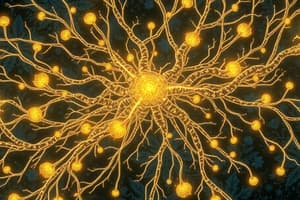Podcast
Questions and Answers
What role do neurotransmitters play in the generation of a new potential in the post-synaptic neuron?
What role do neurotransmitters play in the generation of a new potential in the post-synaptic neuron?
- They inhibit the movement of ions.
- They bind and open ion channels. (correct)
- They directly generate action potentials.
- They are stored in the axon terminal.
Which layer of the cranial meninges directly contacts the brain tissue?
Which layer of the cranial meninges directly contacts the brain tissue?
- Dura mater
- Pia mater (correct)
- Subarachnoid
- Arachnoid
Which part of the brain is primarily responsible for processing vision, hearing, and speech?
Which part of the brain is primarily responsible for processing vision, hearing, and speech?
- Midbrain
- Forebrain (correct)
- Limbic system
- Hindbrain
Which type of neuron is characterized by having one axon and two or more dendrites?
Which type of neuron is characterized by having one axon and two or more dendrites?
What is primarily controlled by the hindbrain?
What is primarily controlled by the hindbrain?
What is the main role of the sodium-potassium pump in a resting neuron?
What is the main role of the sodium-potassium pump in a resting neuron?
What is the function of the nodes of Ranvier in myelinated nerve fibers?
What is the function of the nodes of Ranvier in myelinated nerve fibers?
What is the main function of the midbrain in the central nervous system?
What is the main function of the midbrain in the central nervous system?
What occurs when an action potential arrives at the axon terminal?
What occurs when an action potential arrives at the axon terminal?
In which type of axon are Schwann cells associated with the formation of a myelin sheath?
In which type of axon are Schwann cells associated with the formation of a myelin sheath?
What is the primary reason for the polarized state of a neuron's membrane during resting potential?
What is the primary reason for the polarized state of a neuron's membrane during resting potential?
Where are the specific receptors for neurotransmitters located?
Where are the specific receptors for neurotransmitters located?
What is one of the major functions of the brain as the central information processing organ?
What is one of the major functions of the brain as the central information processing organ?
During which stage of neuronal activity is the membrane potential likely to experience depolarization?
During which stage of neuronal activity is the membrane potential likely to experience depolarization?
Which ions have a higher concentration inside a resting axon compared to the outside?
Which ions have a higher concentration inside a resting axon compared to the outside?
Which statement accurately describes the characteristics of unmyelinated nerve fibers?
Which statement accurately describes the characteristics of unmyelinated nerve fibers?
What initiates the action potential at site B during impulse conduction in an axon?
What initiates the action potential at site B during impulse conduction in an axon?
Which type of synapse allows for direct electrical current flow between neurons?
Which type of synapse allows for direct electrical current flow between neurons?
What is the role of neurotransmitters at chemical synapses?
What is the role of neurotransmitters at chemical synapses?
Why is impulse transmission across electrical synapses considered faster than chemical synapses?
Why is impulse transmission across electrical synapses considered faster than chemical synapses?
What occurs after K+ diffuses outside the axonal membrane during action potential propagation?
What occurs after K+ diffuses outside the axonal membrane during action potential propagation?
Which component is essential for the generation of action potentials in axons?
Which component is essential for the generation of action potentials in axons?
What characterizes the synaptic cleft at chemical synapses?
What characterizes the synaptic cleft at chemical synapses?
What happens to the axon's membrane after action potential generation?
What happens to the axon's membrane after action potential generation?
Flashcards
Synaptic knob
Synaptic knob
The bulb-like structure at the end of a neuron's axon, containing synaptic vesicles with neurotransmitters.
Neurotransmitters
Neurotransmitters
Chemicals stored in synaptic vesicles that transmit signals across synapses.
Myelinated nerve fibers
Myelinated nerve fibers
Nerve fibers covered with a myelin sheath, allowing faster nerve impulse conduction.
Nodes of Ranvier
Nodes of Ranvier
Signup and view all the flashcards
Neuron types
Neuron types
Signup and view all the flashcards
Axon
Axon
Signup and view all the flashcards
Resting membrane potential
Resting membrane potential
Signup and view all the flashcards
Sodium-potassium pump
Sodium-potassium pump
Signup and view all the flashcards
Neurotransmitter release
Neurotransmitter release
Signup and view all the flashcards
Action Potential Transmission
Action Potential Transmission
Signup and view all the flashcards
Synapse
Synapse
Signup and view all the flashcards
Synaptic cleft
Synaptic cleft
Signup and view all the flashcards
Chemical Synapse
Chemical Synapse
Signup and view all the flashcards
Post-synaptic neuron
Post-synaptic neuron
Signup and view all the flashcards
Electrical Synapse
Electrical Synapse
Signup and view all the flashcards
Action potential
Action potential
Signup and view all the flashcards
Neurotransmitters
Neurotransmitters
Signup and view all the flashcards
Brain function
Brain function
Signup and view all the flashcards
Synaptic Cleft
Synaptic Cleft
Signup and view all the flashcards
Cranial meninges
Cranial meninges
Signup and view all the flashcards
Impulse Conduction
Impulse Conduction
Signup and view all the flashcards
Forebrain, Midbrain, Hindbrain
Forebrain, Midbrain, Hindbrain
Signup and view all the flashcards
Synaptic Receptors
Synaptic Receptors
Signup and view all the flashcards
Resting Potential Restoration
Resting Potential Restoration
Signup and view all the flashcards
Study Notes
Neural Control and Coordination
- Coordination is the interaction of organs to maintain homeostasis
- Physical activity increases energy demand, respiration rate, heart rate, and blood flow
- The neural and endocrine systems coordinate bodily functions
- The neural system provides point-to-point connections for fast coordination
- The endocrine system uses hormones for chemical coordination
Neural System
- Highly specialized cells called neurons detect, receive, and transmit stimuli
- Neural organization varies in complexity across species
- Hydra: simple network
- Insects: brain and ganglia
- Vertebrates: more developed system
Human Neural System
- Divided into central nervous system (CNS) and peripheral nervous system (PNS)
- CNS: brain and spinal cord, processes information and controls
- PNS: nerves connecting CNS to other parts, transmits signals
- Afferent fibers: transmit impulses from tissues/organs to CNS
- Efferent fibers: transmit regulatory impulses from CNS
- Somatic neural system: relays impulses to skeletal muscles
- Autonomic neural system: relays impulses to involuntary organs, further classified to sympathetic and parasympathetic systems
- Visceral nervous system: part of the PNS coordinating with viscera
Neuron (Structural and Functional Unit)
- Microscopic structures with cell body, dendrites, and axon
- Cell body: contains cytoplasm and Nissl's granules
- Dendrites: short fibers extending from cell body, receiving impulses
- Axon: long fiber, transmits impulses away from cell body to synapse
- Types of neurons: multipolar, bipolar, unipolar, based on axon and dendrite numbers
Nerve Impulse Generation and Conduction
- Neurons are excitable, maintained in polarized state
- Ion channels on neural membranes selectively permeable to specific ions
- Resting potential: electrical potential difference across resting membrane
- High K⁺ inside, low K⁺ outside, high Na⁺ outside, low Na⁺ inside
- Action potential: rapid reversal of membrane polarity
- Stimulus opens Na⁺ channels, Na⁺ influx, depolarisation
- Na⁺ channels close, K⁺ channels open, repolarisation
Synapse
- Junctions where neurons communicate with each other or with other cells
- Two types of synapses
- Electrical synapse: direct transmission of impulse
- Chemical synapse: neurotransmitters transmit impulse across a cleft
Central Nervous System (CNS)
- Brain: central processing organ, coordinates and controls bodily functions
- Brain structure: forebrain, midbrain, hindbrain
- Forebrain: cerebrum, thalamus, hypothalamus
- Cerebrum: higher mental functions, sensory and motor areas
- Thalamus: relay center for sensory signals
- Hypothalamus: vital functions like body temperature, hunger, thirst, circadian rhythms, emotions
- Midbrain: reflexes and eye movement
- Hindbrain: pons, cerebellum, medulla
- Pons: connects different brain parts
- Cerebellum: coordination and balance
- Medulla oblongata: involuntary actions like breathing and heart rate
- Forebrain: cerebrum, thalamus, hypothalamus
Reflex Action and Reflex Arc
- Involuntary response to stimulus
- Sensory receptor detects stimulus
- Afferent neuron transmits impulse to the CNS (spinal cord)
- Interneuron (if present) processes impulse in the CNS
- Efferent neuron transmits impulse from CNS to effector
- Effector (muscle or gland) responds to impulse
Sensory Reception and Processing
- Sensory organs detect environmental changes
- Signals are processed and interpreted by the brain
- Specialized receptors for different senses (sight, smell, sound, taste)
- Eye: light detection, rods and cones
- Ear: sound detection, cochlea, vestibular apparatus
- Nose: smell detection
- Tongue: taste detection
Studying That Suits You
Use AI to generate personalized quizzes and flashcards to suit your learning preferences.





